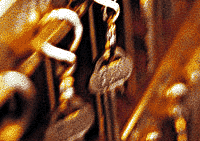The world is at your fingertips when you access the Internet, but so is a lot of danger. If you’re not careful, you will put your computer as well as your identity and privacy at risk. Following these guidelines will protect your personal information and keep your computer safe from attack from viruses and other harmful software.
1. Use Recommended Firewall and Browser Security Settings
 Your computer’s firewall should always be up when you are connected to the Internet. It prevents hackers and harmful software from spying on you or damaging your computer. Likewise, use the manufacturer-recommended security settings on your browser unless you have a specific reason not to.
Your computer’s firewall should always be up when you are connected to the Internet. It prevents hackers and harmful software from spying on you or damaging your computer. Likewise, use the manufacturer-recommended security settings on your browser unless you have a specific reason not to.
2. Use a Secure Internet Connection
If you are connecting to the Internet via a home wireless network, make sure that the network is password-protected. If it isn’t, anyone within range could hypothetically connect to it and spy on your Internet activity. When you’re connected to a public network such an airport or coffee shop Wi-Fi hotspot, avoid submitting sensitive information like account numbers.
3. Utilize Anti-Virus Software
The anti-virus software program on your computer should always be active and up-to-date. If it’s not, it won’t be able to track down the latest harmful software that could make its way you’re your machine. Make sure that your anti-virus program installs updates automatically and regularly performs system scans. It should also scan anything you download or insert from an external device. If your anti-virus program requires a regular subscription, make sure that it is current.
4. Check Website Security Credentials
Any time a webpage asks you to submit sensitive information like a password or an identification number, verify that it is secure. Look at the address bar at the top of your browser. The URL should start with “https://” instead of “http://”. Depending on the browser, the URL may be highlighted green or be in green text. You should also see a small lock symbol either in the address bar or at the bottom of the webpage. Roll your cursor over the lock to view the site’s security credentials or click on it for more information. If none of these indicators are present, you’re not on a secure page and shouldn’t submit any sensitive data.
5. Avoid Phishing Scams
Never click Internet hyperlinks unless you are sure they connect to a legitimate source. Even if you receive a link from a friend, it could be part of a “phishing” scam. Phishing scams are dangerous because they can steal sensitive information like passwords, social security numbers and banking account numbers. You can also inadvertently spread a phishing scam if it sends itself to all of your contacts. Phishing commonly occurs through programs and websites that share information with other people, including email, instant messengers and social networking websites like Facebook.
If you aren’t sure whether a hyperlink is legitimate or not, do some research to confirm its validity. The best way to do this is to contact the sender and ask about it. However, don’t use the potentially phony contact information that you may have received as part of the phishing scam. Instead, contact the sender through another channel, whether that is an institution’s legitimate website or a personal friend’s phone.
